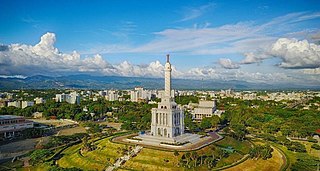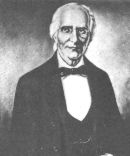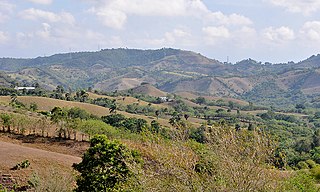Related Research Articles

The Dominican Republic is a country located on the island of Hispaniola in the Greater Antilles archipelago of the Caribbean region. It occupies the eastern five-eighths of the island, which it shares with Haiti, making Hispaniola one of only two Caribbean islands, along with Saint Martin, that is shared by two sovereign states. The Dominican Republic is the second-largest nation in the Antilles by area at 48,671 square kilometers (18,792 sq mi), and third-largest by population, with approximately 10.7 million people, down from 10.8 million in 2020, of whom approximately 3.3 million live in the metropolitan area of Santo Domingo, the capital city. The official language of the country is Spanish.

Hispaniola is an island in the Caribbean that is part of the Greater Antilles. Hispaniola is the most populous island in the West Indies, and the region's second largest in area, after the island of Cuba.

Rafael Leónidas Trujillo Molina, nicknamed El Jefe, was a Dominican dictator who ruled the Dominican Republic from August 1930 until his assassination in May 1961. He served as president from 1930 to 1938 and again from 1942 to 1952, ruling for the rest of the time as an unelected military strongman under figurehead presidents. His rule of 31 years, known to Dominicans as the Trujillo Era, is considered one of the bloodiest and most corrupt regimes in the Western hemisphere, and centered around a personality cult of the ruling family. Trujillo's security forces, including the infamous SIM, were responsible for perhaps as many as 50,000 murders, including between 12,000 and 30,000 Haitians in the infamous Parsley massacre in 1937, which continues to affect Dominican-Haitian relations to this day.

Santiago is a province which currently comprises one of the 32 provinces of the Dominican Republic. It is divided into 10 municipalities and its capital city is Santiago de los Caballeros. Located in north-central Dominican Republic, in the Cibao region, it is bordered by the provinces of Valverde to the north-west, Puerto Plata to the north, Espaillat and La Vega to the east, San Juan to the south and Santiago Rodríguez to the west.

Santiago de los Caballeros, often shortened to Santiago, is the second-largest city in the Dominican Republic and the fourth-largest city in the Caribbean by population. It is the capital of Santiago Province and the largest major metropolis in the Cibao region of the country. Santiago is the largest Caribbean city that isn’t a capital city, and it is also the largest non-coastal metropolis in the Caribbean islands. The city has a total population of 1,173,015 inhabitants. Santiago is located approximately 155 km (96 mi) northwest of the capital Santo Domingo with an average altitude of 178 meters (584 ft).

The first United States occupation of the Dominican Republic lasted from 1916 to 1924. It was one of the many interventions in Latin America undertaken by the military forces of the United States in the 20th century. On May 13, 1916, Rear Admiral William B. Caperton forced the Dominican Republic's Secretary of War Desiderio Arias, who had seized power from President Juan Isidro Jimenes Pereyra, to leave Santo Domingo by threatening the city with naval bombardment. The Marines landed three days later and established effective control of the country within two months. The U.S. occupations of Haiti and the Dominican Republic led to clashes that killed 290 U.S. Marines, over 3,000 Haitians, and hundreds of Dominicans. Despite having much greater firepower, it took the U.S. Marines five years to suppress an insurgency in the eastern provinces of El Seibo and San Pedro de Macorís.

The Yaque Del Norte River is the longest river in the Dominican Republic, as well as the second longest river on Hispaniola, behind the Artibonite River. It is 296 km long and flows northwest into the Atlantic Ocean.

Ulises Francisco Espaillat Quiñones was a Dominican author and politician. He served as president of the Dominican Republic from April 29, 1876, to October 5, 1876. Espaillat Province is named after him.

Baitoa is a municipality in the Santiago Province of the Dominican Republic. Santiago is part of the northern valley of the country, otherwise known as the Cibao. Baitoa is named after a native tree, also known as St. Domingo Boxwood. Baitoa was formerly known as Sabana de los Burros. The population speaks a Cibao dialect of Dominican Spanish.

The following outline is provided as an overview of and topical guide to the Dominican Republic:
Julio Vega Batlle was a Dominican writer, publishing both plays and novels, and a diplomat. He was born in Santiago de los Caballeros, and graduated from the University of Santo Domingo. He became a judge, and served as a diplomat for the Dominican Republic on missions to London, England; Havana, Cuba; and Rio de Janeiro, Brazil.

Manuel del Cabral was a Dominican poet, writer, and diplomat. The son of Mario Fermín Cabral y Báez, an influential senator during the "Era of Trujillo", he served at the Embassy of the Dominican Republic to Argentina. During his long stay in Buenos Aires, he married an Argentine and fathered his 4 children, among them, the television journalist and politician Peggy Cabral. In 1992 he was awarded the Premio Nacional de Literatura.

Richard Clark Barkley was a United States diplomat. From December 1988 until October 1990, he was the last United States Ambassador to East Germany. After that, from 1991 to 1994, he was the United States Ambassador to Turkey.

Tourism in the Dominican Republic is an important sector of the country's economy. More than 8.5 million tourists visited the Dominican Republic in 2022, making it the most popular tourist destination in the Caribbean and putting it in the top 5 overall in the Americas. The industry accounts for 11.6% of the nation's GDP and is a particularly important source of revenue in coastal areas of the country. The nation's tropical climate, white sand beaches, diverse mountainous landscape and colonial history attracts visitors from around the world.
The Dominican Civil War (1914) was a civil war in the Dominican Republic that started as a rebellion against the government led by General Desiderio Arias in La Vega and Santiago de los Caballeros, beginning on March 30, 1914. José Bordas Valdez was elected President without opposition on June 15, 1914. The U.S. Navy ships intervened to end the bombardment of Puerto Plata beginning on June 26, 1914. The U.S. Army troops were deployed in support of the government in Santo Domingo in July 1914. The U.S. government mediated the signing of a ceasefire agreement between government and rebel representatives on August 6, 1914. Some 500 individuals were killed during the conflict.
Eduardo José Lorenzo Casasnova is a sports shooter who competed for the Dominican Republic in the 2016 Summer Olympics. He won the gold medal in the 2014 Pan American Championship in trap and the silver in trap team. He is also multimedalist in the Central American and Caribbean Games having won the gold medal in trap team in 2010 and 2014, silver in trap team in Trap Team and the 2014 trap competition and also the trap team bronze in 2002.
The 2018 Caribbean Club Shield was the first edition of the Caribbean Club Shield, the second-tier annual international club football competition in the Caribbean region, held amongst clubs whose football associations are affiliated with the Caribbean Football Union (CFU), a sub-confederation of CONCACAF. The tournament was played in the Dominican Republic between 13–21 April 2018.

José Armando Castillo also known as El Mago(the magician), is a retired baseball and fastpitch softball pitcher of the Dominican Republic National Team. He has won several gold medals in softball in various Central American and Caribbean Games and has been a national trainer in softball. He has been selected as the Softball Player of the Century in the Dominican Republic as well as added to the Corridor of Athletes of Merit of Santiago by the Sports Press Association of Santiago de los Caballeros, Dominican Republic. In 2016, José Armando was inducted to the Hall of Fame of the Sports of Santiago.
Danilo Cabrera is a former professional boxer from the Dominican Republic. Known in professional boxing circles as "Cuero Duro", he fought for world championships three times, losing to International Boxing Hall of Fame members Barry McGuigan, Azumah Nelson and Julio Cesar Chavez Sr., respectively.

Italian Dominicans are Dominican-born citizens who are fully or partially of Italian descent, whose ancestors were Italians who emigrated to the Dominican Republic during the Italian diaspora, or Italian-born people in the Dominican Republic. The Italian community in the Dominican Republic, considering both people of Italian ancestry and Italian birth, is the largest in the Caribbean region.
References
- ↑ Chief of Protocol , Ambassadors to the United States: Chronological Listing by Country
- ↑ "History - Dominicans on Wall Street". Archived from the original on 2014-05-18.
- ↑ Ameringer, Charles (November 2010). Caribbean Legion: Patriots, Politicians, Soldiers of Fortune, 1946-1950. ISBN 978-0271042183.